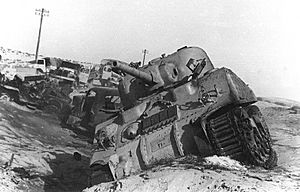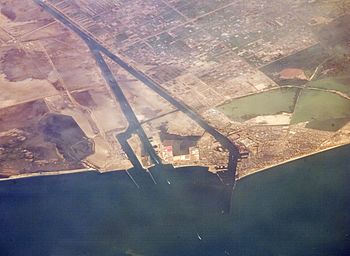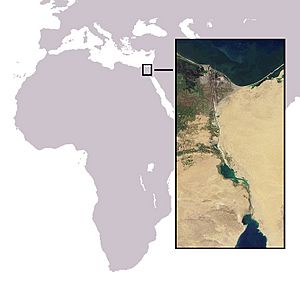Suez Crisis facts for kids
Quick facts for kids
|
|||||||
|---|---|---|---|---|---|---|---|
| Part of the Cold War, Israeli–Palestinian conflict, and the Arab–Israeli conflict | |||||||
 Damaged Egyptian vehicles |
|||||||
|
|||||||
| Belligerents | |||||||
|
|
|||||||
| Commanders and leaders | |||||||
|
|
||||||
| Strength | |||||||
| Casualties and losses | |||||||
|
|
||||||
The Suez Crisis, also known as the Second Arab–Israeli War or the Sinai War, was a short conflict in 1956. It involved an invasion of Egypt and the Gaza Strip by Israel, followed by the United Kingdom and France. The main goal was to take back control of the Suez Canal for Britain and France. They also wanted to remove Egypt's president, Gamal Abdel Nasser. He had recently taken control of the Suez Canal Company, which was owned by British and French investors.
Israel's main goal was to open the Straits of Tiran, a waterway that Egypt had blocked. The fighting started on October 29, 1956. British and French paratroopers landed near the canal on November 5. Egyptian forces blocked the canal by sinking 40 ships.
Soon, it became clear that Israel, France, and Britain had secretly planned this invasion together. Even though they achieved some military goals, the canal became unusable. Strong pressure from the United States and the Soviet Union forced the three countries to pull out. The U.S. president, Dwight D. Eisenhower, even threatened to harm Britain's economy.
This event was a big embarrassment for the United Kingdom and France. It also made President Nasser stronger in the Middle East. The Suez Canal was closed from October 1956 until March 1957. After the conflict, the United Nations created the UNEF Peacekeepers. They were sent to watch over the border between Egypt and Israel.
Contents
Why the Suez Crisis Happened
The Suez Canal's Importance
The Suez Canal was finished in 1869. It took ten years to build and was paid for by the French and Egyptian governments. The canal was managed by the Universal Company of the Suez Maritime Canal. The land around the canal was still Egyptian territory.
The canal quickly became very important for trade. It offered the shortest sea route between the Mediterranean Sea and the Indian Ocean. This made trade easier and helped European countries manage their colonies.
In 1875, Egypt had money problems and had to sell its shares in the canal company. The British government bought these shares, getting a 44% ownership. In 1882, Britain took control of Egypt and the canal. The Convention of Constantinople in 1888 said the canal was a neutral zone. It allowed ships from all countries to pass through freely, even during wars.
The canal's importance was clear during the Russo-Japanese War (1904–1905). Britain stopped Russian ships from using the canal. This forced the Russian fleet to sail all the way around Africa. This gave Japan more time to prepare. The canal was also vital during the First World War. Britain and France closed it to enemy ships.
Oil and the Canal
After World War II, the Suez Canal became very important for shipping oil. By 1955, half of the canal's traffic was oil. Two-thirds of Europe's oil came through the canal. This made the canal a key route for Europe's energy supply.
British leaders thought controlling the canal was vital for their country. They believed it was needed to meet military duties and transport supplies. However, large oil tankers were becoming too big for the canal. This meant its importance for oil was actually overestimated by some.
Egypt After World War II
After World War II, Britain had a large military base in Suez. It had about 80,000 soldiers. This base was important for Britain's power in the Middle East. But it also caused problems with Egypt.
Egypt was going through big changes. There was economic trouble and unemployment. People became more hostile towards Britain. Many Egyptians were also angry about Britain's role in creating Israel.
In 1951, Egypt ended a treaty that allowed Britain to lease the Suez base. Britain refused to leave, saying it had treaty rights. This led to more violence against British troops. On January 25, 1952, British forces killed 41 Egyptians in Ismailia. This led to riots in Cairo and the end of the Egyptian monarchy. On July 23, 1952, a military group led by Gamal Abdel Nasser took over. They created an Egyptian republic.
Egypt's New Leaders and Global Politics
Egypt and Britain's Changing Relationship
After the military takeover, Britain tried to improve relations with Egypt. In 1954, they agreed that British troops would leave the Suez base within 20 months. Britain would still have the right to return for seven years if needed. The Suez Canal Company was not supposed to become Egyptian until 1968.
Nasser was worried about Britain's close ties with Iraq and Jordan. He wanted Egypt to lead the Arab world. The creation of the Baghdad Pact in 1955, which included Iraq and Britain, made Nasser fear Britain was trying to control the region. Nasser then began to challenge British influence.
Egypt and Arab Leadership
Nasser wanted Egypt to be the main leader of the Arab world. He often spoke out against Western influence. He also used radio to call for the overthrow of governments friendly to Britain, like Iraq's.
Nasser felt his power was not secure. He believed Egypt would not be truly independent until it led the Arab world. This led him to challenge British interests throughout 1955.
The United States and the Cold War
The United States wanted to stop the Soviet Union from gaining influence in the Middle East. They tried to create a defense alliance there. The U.S. saw Egypt as key to this plan.
However, the U.S. also had to balance its friendships. Britain and France were strong allies, but they were also colonial powers. Many local leaders resented their influence. The U.S. wanted Arab countries and Israel to unite against the Soviet Union. But Arab states were more worried about Zionism than Communism.
Nasser was friendly with some CIA officers. This made the U.S. think they had more influence over him. But Nasser was playing both sides. He took $3 million from the CIA but refused to join their alliance. He told the U.S. that Britain was the real problem, not the Soviet Union.
Nasser Buys Weapons
Nasser wanted to buy weapons from the United States. But he refused to promise not to use them against Israel. The U.S. also wanted to send military advisors, which Nasser rejected. American public opinion was against selling arms to Egypt that might be used against Israel.
In 1950, the U.S., Britain, and France signed the Tripartite Declaration. This agreement limited how many weapons they would sell to countries in the Middle East. Eisenhower believed this helped keep peace.
Nasser then hinted he might buy weapons from the Soviet Union. The Soviet Union, led by Nikita Khrushchev, wanted to gain influence in the Middle East. They were happy to sell weapons to Egypt. In September 1955, Egypt announced a huge arms deal with Czechoslovakia, a Soviet ally. This shocked Western countries. They saw it as a big increase in Soviet power in the region.
France and Algeria
At the same time, France was fighting a rebellion in Algeria. The Algerian rebels were supported by Egypt. Egypt sent them money from Suez Canal profits and secretly shipped them weapons. French leaders, like Premier Guy Mollet, saw Nasser as a major threat. They compared him to Adolf Hitler, saying he wanted to control the entire Middle East. France began to see Israel as an ally against Egypt.
Egypt and Israel's Tensions
Before 1955, Nasser had tried to make peace with Israel. He also tried to stop Palestinian attacks across the border. But in February 1955, an Israeli unit attacked an Egyptian army base in Gaza. This was in response to a Palestinian attack that killed an Israeli civilian. After this, Nasser allowed Palestinian fighters to raid Israel. These raids led to more Israeli counter-attacks, which added to the tensions leading to the Suez Crisis.
France and Israel Become Allies
France and Israel started working together on nuclear research in 1949. After the Algerian War began in 1954, France sent more and more weapons to Israel. By 1955, France was Israel's closest ally. In April 1956, Israel told France it planned to go to war with Egypt. Israel believed Nasser wanted to destroy their country. They wanted to fight before Egypt got more Soviet weapons.
Britain's Frustration with Nasser
Throughout 1955 and 1956, Nasser made moves that upset Britain. He saw Iraq joining the Baghdad Pact as a sign that the U.S. and Britain supported his rival, Nuri al-Said. Nasser's anti-Western policies grew because of this.
Nasser also tried to get Saudi Arabia to join him against Britain's allies. He made a deal to buy arms from communist Czechoslovakia in September 1955. This ended Egypt's reliance on Western weapons. Other Soviet-allied countries also sold arms to Egypt. This increased Soviet influence in the Middle East.
Key Events in 1956
Nasser and Jordan
Nasser also stopped Britain from getting Jordan to join the Baghdad Pact. He supported protests in Amman, Jordan. This led Jordan's King Hussein of Jordan to fire the British commander of the Jordanian army in March 1956. King Hussein told Britain privately that he was still their ally. But he had to fire the British officers to calm the rioters.
Nasser and British Leaders
British Prime Minister Anthony Eden was very angry about the firing of the British commander. He saw it as a big blow to British influence. Eden became convinced that Nasser was his main enemy. From March 1956, Eden secretly wanted to overthrow Nasser.
British leaders, especially Eden, started to see Nasser as a dictator. They compared him to Benito Mussolini. Relations between Britain and Egypt continued to get worse. Britain wanted the U.S. to support military action against Nasser. But Eisenhower was strongly against it. The U.S. wanted to increase its own influence in the region.
The Aswan High Dam and the U.S.
On May 16, 1956, Nasser officially recognized the People's Republic of China. This angered the U.S. and Secretary of State John Foster Dulles. This, along with doubts about Egypt's ability to pay, led Eisenhower to withdraw U.S. financial aid for the Aswan Dam project on July 19.
The U.S. believed that if the Soviet Union tried to fund the dam, it would be too expensive for them. This would strain Soviet-Egyptian relations. Eisenhower was also annoyed that Nasser was trying to play the U.S. and the Soviet Union against each other.
U.S. Peace Efforts in 1956
In January 1956, Eisenhower tried to make peace between Egypt and Israel. He sent a special envoy, Robert B. Anderson, to secretly negotiate. Anderson offered a lot of American aid if Egypt would sign a peace treaty with Israel.
Nasser demanded that Palestinian refugees return to Israel. He also wanted to take over the southern part of Israel. He refused to talk directly with Israel. Israel's Prime Minister David Ben-Gurion doubted Nasser was serious about peace.
A second round of talks in February 1956 also failed. Nasser sometimes hinted he was interested in peace if he got unlimited American aid and weapons. It is not clear if Nasser truly wanted peace. He was a very private person. But his desire to be the leading anti-Zionist state made peace unlikely.
The Canal is Nationalized

Nasser's response to the U.S. withdrawing aid was to take control of the Suez Canal. On July 26, in a speech in Alexandria, Nasser announced that the Suez Canal Company was now owned by Egypt. He said all its assets were frozen. Shareholders would be paid for their shares based on the stock market price.
On the same day, Egypt closed the canal to Israeli shipping. Egypt also blocked the Straits of Tiran, which was against an international agreement from 1888. Many people also said this broke the 1949 Armistice Agreements.
Some historians believe Nasser's decision to nationalize the canal without much discussion showed he made decisions alone.
Images for kids



